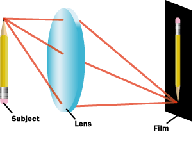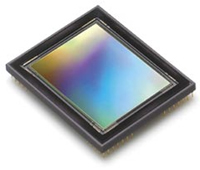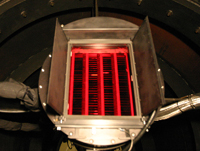|
Digital Cameras:
Light waves travel at very high velocities. In order to form a photographic image, the photons comprising the light waves need to be slowed down and redirected onto another medium that collects them.  Cameras use an optical lens (usually a curved piece of glass) to slow down and refocus the photons. In a film-based camera, the photons are focused onto a sheet of film. In a digital camera, the photons are focused onto a processor called a CCD (charged-couple device). The CCD, invented in 1969, has replaced the function of film and has taken photographic imaging to much greater heights, especially in the field of astronomy. Cameras use an optical lens (usually a curved piece of glass) to slow down and refocus the photons. In a film-based camera, the photons are focused onto a sheet of film. In a digital camera, the photons are focused onto a processor called a CCD (charged-couple device). The CCD, invented in 1969, has replaced the function of film and has taken photographic imaging to much greater heights, especially in the field of astronomy.
A CCD is an image processor comprised of silicon chips that are light sensitive. They used to be sensitive to only infrared, visible and ultraviolet light. Now, they can detect x-ray light (through a cooling process) and gamma ray light (through a process known as Compton scattering).  CCDs contain thousands of pixels (photon detectors) which capture the activity of the photons as they emerge from the lens. Every time a photon hits a pixel, an electron is released. This charged particle then moves to form an analog current. h The incoming photons produce a pattern of charges on the chip which an image processing program on a computer can then convert into digital images, visible to the human eye. If a color picture is desired, a beam may be used to divide the light up and push it through the various color sensors (usually light’s three primary colors of blue, red and green are used). In such a case, each pixel location will contain a record of the amount of each of the three primary colors within that pixel. CCDs contain thousands of pixels (photon detectors) which capture the activity of the photons as they emerge from the lens. Every time a photon hits a pixel, an electron is released. This charged particle then moves to form an analog current. h The incoming photons produce a pattern of charges on the chip which an image processing program on a computer can then convert into digital images, visible to the human eye. If a color picture is desired, a beam may be used to divide the light up and push it through the various color sensors (usually light’s three primary colors of blue, red and green are used). In such a case, each pixel location will contain a record of the amount of each of the three primary colors within that pixel.
 Numerous CCD based cameras work in collaboration with telescopes to capture images of the universe. Some reside on satellites, others do not. The QUEST Camera (see image to your right) is part of the Samuel Oschin Telescope at Palomar Labs in California. Numerous CCD based cameras work in collaboration with telescopes to capture images of the universe. Some reside on satellites, others do not. The QUEST Camera (see image to your right) is part of the Samuel Oschin Telescope at Palomar Labs in California.
Astronomers prefer using CCDs over film because it enables them to record very faint objects in a relatively short amount of time as compared to film. The CCD itself may be used over and over to collect additional images. Film, on the other hand, is used once and needs to be replaced. Also, the image that results from a CCD may be previewed, edited and customized with various colors that will reflect the data presentation needs of the scientist, astronomer, or graphic artist. Film does not have these qualities.
Another example of how a CCD can help an astronomer is the following: An astronaut traveling on a satellite might take a non-filtered picture of what appears to be a cloud of dust in the sky. The dust particles are radiating out to the astronaut at a speed of 600 nm and thus are “visible” to him. If that same astronaut were to take a picture using a special type of digital camera utilizing an Infrared CCD, the dust would disappear and the brilliant star behind the dust would shine through in the picture. CCDs, the most significant ingredient in digital imaging have forever changed our view of the universe!
|





 Cameras use an optical lens (usually a curved piece of glass) to slow down and refocus the photons. In a film-based camera, the photons are focused onto a sheet of film. In a digital camera, the photons are focused onto a processor called a CCD (charged-couple device). The CCD, invented in 1969, has replaced the function of film and has taken photographic imaging to much greater heights, especially in the field of astronomy.
Cameras use an optical lens (usually a curved piece of glass) to slow down and refocus the photons. In a film-based camera, the photons are focused onto a sheet of film. In a digital camera, the photons are focused onto a processor called a CCD (charged-couple device). The CCD, invented in 1969, has replaced the function of film and has taken photographic imaging to much greater heights, especially in the field of astronomy. CCDs contain thousands of pixels (photon detectors) which capture the activity of the photons as they emerge from the lens. Every time a photon hits a pixel, an electron is released. This charged particle then moves to form an analog current. h The incoming photons produce a pattern of charges on the chip which an image processing program on a computer can then convert into digital images, visible to the human eye. If a color picture is desired, a beam may be used to divide the light up and push it through the various color sensors (usually light’s three primary colors of blue, red and green are used). In such a case, each pixel location will contain a record of the amount of each of the three primary colors within that pixel.
CCDs contain thousands of pixels (photon detectors) which capture the activity of the photons as they emerge from the lens. Every time a photon hits a pixel, an electron is released. This charged particle then moves to form an analog current. h The incoming photons produce a pattern of charges on the chip which an image processing program on a computer can then convert into digital images, visible to the human eye. If a color picture is desired, a beam may be used to divide the light up and push it through the various color sensors (usually light’s three primary colors of blue, red and green are used). In such a case, each pixel location will contain a record of the amount of each of the three primary colors within that pixel. Numerous CCD based cameras work in collaboration with telescopes to capture images of the universe. Some reside on satellites, others do not. The
Numerous CCD based cameras work in collaboration with telescopes to capture images of the universe. Some reside on satellites, others do not. The